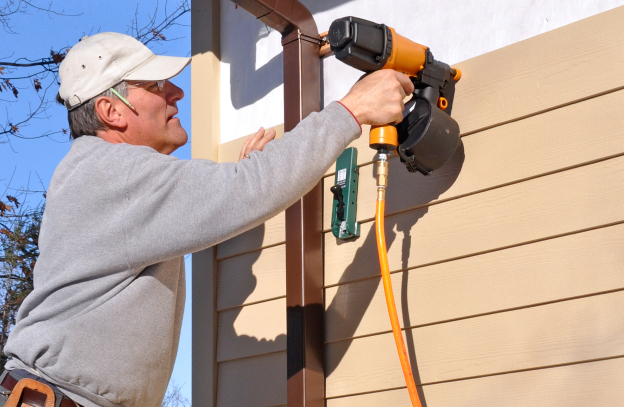Best Composite Siding Choices
 Gary Cohoon has been selling and installing siding for more than 30 years. However, he believes that much of his extensive knowledge about siding will soon become obsolete.
Gary Cohoon has been selling and installing siding for more than 30 years. However, he believes that much of his extensive knowledge about siding will soon become obsolete.
Composite Siding that will "Take Over the Market"
Cohoon owns Cherokee Home Exteriors in the Atlanta area. Several years ago, he started selling a new composite siding product that’s “going to take over the market,” he said. Working with the new material, a mix of polymers and wood fibers, requires special training and a different installation method from siding jobs he has completed for decades. However, once installed, it's the best option on the market according to Cohoon, short of brick and real wood siding, which can both be prohibitively expensive for most homeowners.
Advantages of Polymer-Wood Siding
Cohoon explains that the new polymer-wood hybrid is more attractive and sturdy than vinyl siding, but more durable and inexpensive than wood. He also claims that new composites have advantages over fiber-cement and other composite siding options. However, other siding dealers and installers still tout fiber-cement as the best composite option.
Buyer Beware
Both polymer-wood hybrids and fiber-cement siding products help improve the reputation of composite siding. In the past, various composite siding products wrapped homes only to develop serious problems such as swelling, mold attraction, and delamination. Georgia-Pacific, Louisiana-Pacific, Masonite, and other manufacturers were targets of large, successful class-action lawsuits as a result.
Homeowners need to make sure they get quality products, and hire an experienced professional for installation. A lousy siding job can lead to expensive and dangerous problems.
Wood-Polymer Composite on the Market
Cohoon compared the new wood-polymer options to Trex decking for home exteriors. Both products are a mix of wood fibers and PVC plastic. The siding is sold primarily under the Alside Revolution brand, but Cohoon predicts that most siding manufacturers will develop similar competing products.
Revolution siding is made with recycled wood, and is currently available in nine colors ranging from white to red “Tuscan Clay.” Alside claims independent lab tests showed Revolution siding can withstand a Category 5 hurricane, and is more impact-resistant than fiber-cement or real cedar.
Contractors who install Revolution siding need to complete an Alside training course to learn a construction system that is different from every other siding installation, Cohoon said. The siding panels stack atop each other and attach with nail clips. The system has no face nails or caulking. Both are major causes of problems with other types of siding.
Cohoon states that the installation system has a steep learning curve, but then it is nearly foolproof.
Wood-Polymer vs Fiber-Cement Composite Siding
Chris Short is the manager of window and siding sales at Quality Roofing and Siding in Schenectady, N.Y. His firm sells James Hardie fiber-cement siding, and it is the second biggest seller after standard vinyl siding.
Short says his company started distributing Hardie products after trying other composites and not seeing as much success with results. He points out that the fiber-cement siding lasts for many years, and is available in a range of attractive colors and styles.
Cohoon is less keen on fiber-cement. He asserts that the product may seem inexpensive, but the costs of installation and maintenance for most fiber-cement products add up over time. The siding must be primed and painted upon installation, then redone every five to seven years throughout the life of the home. Wood-polymer composite panels cost more than fiber-cement, but the lifetime costs are lower.
Wood-polymer blends and fiber-cement panels are the best and most popular composite siding options, according to some experienced industry experts.
Updated January 21, 2018.
Looking for a Pro? Call us (866) 441-6648

Remodeling Average Costs
Remodeling Contractors Experiences

Roof Repair To Keep Out Miami Rainstorms

Partial Siding Replacement To Get Rid Of Dry Rot



